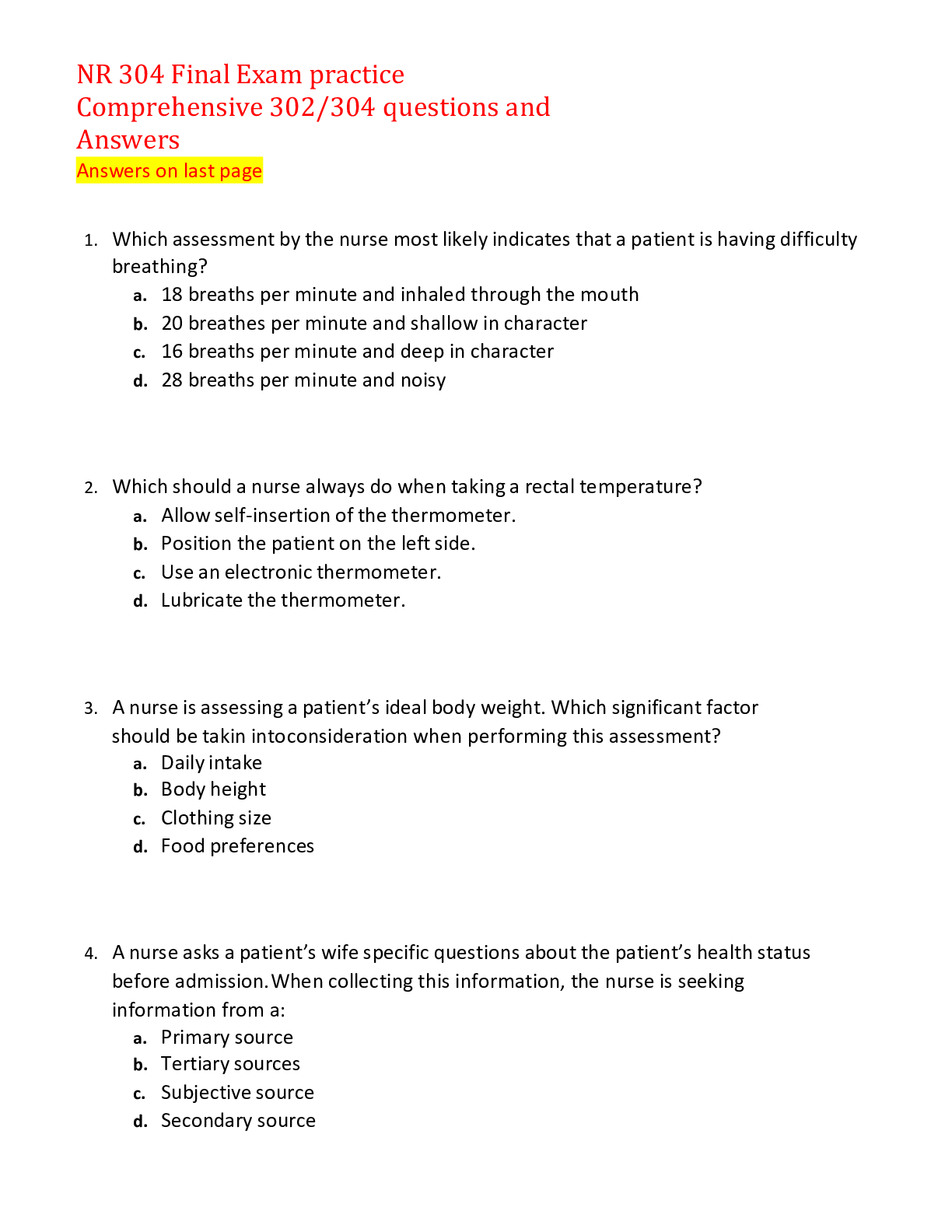Computer Science > QUESTIONS & ANSWERS > Pediatric Advanced Life Support (PALS) Exam Questions 90 Questions with 100% Correct Answers (All)
Pediatric Advanced Life Support (PALS) Exam Questions 90 Questions with 100% Correct Answers
Document Content and Description Below
Pediatric Advanced Life Support (PALS) Exam Questions 90 Questions with 100% Correct Answers 1 rescuer compression to breath ratio in pediatrics? - ✔✔30:2 2 rescuer compression to breath ratio ... in pediatrics? - ✔✔15:2 You need to provide rescue breaths to a child victim with a pulse. What is the appropriate rate for delivering breaths? A.) 1 breath every 3 to 5 seconds B.) 2 breaths every 6-8 secs C.) 1 breath every 6 secs D.) 1 breath every 10-12 secs - ✔✔A.) 1 breath every 3 to 5 seconds An infant's (birth-1 yr old) pulse is checked at the A.) Carotid artery B.) Femoral artery C.) Brachial artery D.) Any of the above - ✔✔C.) Brachial artery (inside of upper arm btwn elbow & shoulder) BP should be at least _______ for infants receiving CPR with an arterial line in place - ✔✔25 mmHg BP should be at least ______ for children receiving CPR with an arterial line in place - ✔✔30 mmHg Admin the initial dose of epinephrine within _______ mins from the start of chest compressions - ✔✔5 Compression depth for infants (birth-1 yr old) should be - ✔✔1/3 of the chest, usually 1.5" (4 cm)Someone on your team asks you to do something outside your scope of practice. A proper communication response is to: A.) Offer to help out with a different task B.) Perform the task C.) Refuse to do the task D.) Seek expert consultation - ✔✔A.) Offer to help out with a different task Compression depth for children should be - ✔✔1/3 of the chest, usually 2 inches (5 cm) If you are the only person at the scene and find an unresponsive infant or child, perform CPR for - ✔✔2 minutes BEFORE calling EMS or getting an AED If you are the only person & witness a cardiac arrest (V-fib & pulseless V-tach) in an infant or child --> - ✔✔call EMS and get an AED BEFORE starting CPR A child's (1+ yrs old) pulse is checked at the - ✔✔carotid artery on the side of the neck or the femoral pulse on the inner thigh Norm BP for children 3-7 yrs old (preschool & school-age) - ✔✔89-115 / 46-76 even lower BP for infants & toddlers Norm HR for newborns to 1 yr old - ✔✔107-180 bpm Norm RR for newborns to 6 yrs - ✔✔21-35 /min Children have ____________ metabolic rates compared to adults? - ✔✔higher The primary assessment includes all of the following assessments except; A.) Airway B.) BreathingC.) Choking D.) Exposure - ✔✔Choking Which of the following is a sign of upper airway obstruction? A.) Fever B.) Stridor C.) Nasal flaring D.) Itching - ✔✔Stridor The following is an indication of poor ventilation: A.) HTN B.) Hyperthyroidism C.) Hypercarbia D.) None of the above - ✔✔Hypercarbia All of the following cause sinus tachycardia except: A.) Metabolic stress B.) Mobitz type II block C.) Fever D.) Acute blood loss - ✔✔B.) Mobitz Type II block Common causes of acute community-acquired pneumonia include which of the following? A.) Streptococcus pneumonia B.) Mycoplasma pneumonia C.) Chlamydia pneumonia D.) All of the above - ✔✔D? All of the above Hypoxemia is defined as a room air SpO2 reading less than _______ in a childA.) 98% B.) 94% C.) 90% D.) 96% - ✔✔B.) 94% Common causes of upper airway obstruction include all of the following except: A.) aspirated foreign body B.) asthma C.) allergic reactions D.) peritonsillar abscess - ✔✔B.) Asthma The following may be used in the treatment of croup: A.) dexamethasone B.) nebulized epinephrine C.) oxygen D.) all of the above - ✔✔D.) all of the above Which statement concerning asystole is not correct? A.) Asystole is a state of no myocardial contractions and no cardiac output or blood flow B.) An asystolic person has no detectable electrical activity C.) A flat line on an ECG always indicates asystole D.) Asystole is one of the rhythms associated with cardiac arrest - ✔✔C.) A flat line on an ECG always indicates asystole Types of shock include all of the following except: A.) Anaphylactic shock B.) Hypovolemic shock C.) Cardiogenic shock D.) Hypothermic shock - ✔✔D.) Hypothermic shockWhen providing fluid resuscitation in children, how should intravenous fluid boluses be given? A.) 15 mL/kg bolus over 5-20 minutes B.) 20 mL/kg bolus over 5-20 minutes C.) 25 mL/kg bolus over 5-20 minutes D.) 30 mL/kg bolus over 5-20 minutes - ✔✔B.) 20 mL/kg bolus over 5-20 minutes Effectiveness of fluid resuscitation and medication therapy should be frequently monitored by which of the following? A.) Heart rate (HR) B.) Blood pressure (BP) C.) Mental status D.) All of the above - ✔✔D.) All of the above Common S/S of compensated shock include: A.) Excessive sweating B.) Increased heart rate C.) Wide pulse pressure D.) Hypertension - ✔✔B.) Increased heart rate When should vasopressors be administered during the management of septic shock? A.) When the person is responding to fluid resuscitation B.) When the person is severely hypotensive despite proper fluid management C.) Alway indicated as soon as IV access is obtained D.) Vasopressors are never used for septic shock - ✔✔B.) When the person is severely hypotensive despite proper fluid management For fluid resuscitation in hypovolemic shock, give about _______ of crystalloid for every ______ of blood lost A.) 1 mL, 2 mLB.) 3 mL, 2 mL C.) 3 mL, 1 mL D.) 2 mL, 3 mL - ✔✔C.) 3 mL, 1 mL Hypoglycemia is defined as _________ in infants, children, and adolescents. A.) >/= 40 mg/dL B.) >/= 50 mg/dL C.) </= 60 mg/dL D.) </= 70 mg/dL - ✔✔C.) </= 60 mg/dL The gold standard for anaphylactic shock is A.) Milrinone B.) Epinephrine C.) Dopamine D.) Dobutamine - ✔✔B.) Epinephrine The preferred order of drug delivery routes are: A.) IV route, IO route, ET route B.) ET route, IV route, IO route C.) IO route, ET route, IV route D.) IV route, ET route, IO route - ✔✔A.) IV route, IO route, ET route Which rhythm should be shocked? A.) Ventricular fibrillation B.) Pulseless ventricular tachycardia C.) Pulseless electrical activity (PEA) D.) Both A & B - ✔✔D.) Both A & BWhen performing rescue breathing on a child or infant, give: A.) 1 breath every 3 seconds B.) 1 breath every 5 seconds C.) 1 breath every 10 seconds D.) 40 breaths per minute - ✔✔A.) 1 breath every 3 seconds In a scenario where there is more than 1 rescuer for a pediatric patient, the recommended compression to breath ratio is: A.) 30:2 B.) 15:1 C.) 15:2 D.) 30:1 - ✔✔C.) 15:2 Which of the following CPR compression techniques is recommended for an infant with more than 1 rescuer present: A.) 1 hand compressions B.) 2 hand compressions C.) 2 finger compressions D.) 2 thumb encircling compressions - ✔✔D.) 2 thumb encircling compressions In children & infants, what is the condition that frequently precedes cardiac arrest & is the reason why ventilation is emphasized strongly in children and infant CPR? A.) Malaria B.) Heart Abnormality C.) Respiratory Failure D.) Coronary artery disease (CAD) - ✔✔C.) Respiratory Failure You are taking a walk in the park & see a child collapse while playing with friends. You approach the child, instruct a nearby adult to call for help and observe that the child is not breathing & does not have a pulse. You should conduct:A.) The primary assessment B.) The secondary assessment C.) CPR D.) Rescue breathing - ✔✔C.) CPR Which of the following is not one of the 3 components of the initial impression? A.) Breathing B.) Consciousness C.) Color D.) Pulse - ✔✔D.) Pulse The ABCDE approach in the primary assessment stands for: A.) Airway, Breathing, Circulation, Disability, Exposure B.) Airway, Breathing, Circulation, Diagnose, Explain C.) Airway, Breathing, Circulation, Diagnose, Exposure D.) Airway, Breathing, Circulation, Defibrillation, Explain - ✔✔A.) Airway, Breathing, Circulation, Disability, Exposure Which of the following airway interventions is the best intervention for a patient with a "Non Maintainable" airway status? A.) Nasopharyngeal airway (NPA) B.) Oropharyngeal airway (OPA) C.) Head tilt- Chin Lift Maneuver D.) Endotracheal intubation - ✔✔D.) Endotracheal intubation Abnormal RR can be distinguished as which of the following? A.) Tachypnea B.) Bradypnea C.) ApneaD.) All of the above - ✔✔D.) All of the above ***Initial impression of a 2-year old girl shows her to be alert with mild breathing difficulty during inspiration and pale skin color. On primary assessment, she makes high pitched inspiratory sound (mild stridor) when agitated; otherwise, intercostal retractions. Lung auscultation reveals transmitted upper airway sounds with adequate distal breath sounds bilaterally. Which is the most appropriate initial intervention for this child? A.) IV dexamethasone B.) Endotracheal intubation C.) Humidified oxygen as tolerated D.) Nebulized albuterol - ✔✔C.) Humidified oxygen as tolerated You are called to help treat an infant with severe symptomatic bradycardia (HR 66/min) associated with respiratory distress. The bradycardia persists despite establishment of an effective airway, oxygenation, and ventilation. There is no heart block present. Which is the first drug you should administer? A.) Epinephrine B.) Atropine C.) Adenosine D.) Dopamine - ✔✔A.) Epinephrine A 9-year old boy is agitated and leaning forward on the bed in obvious respiratory distress. The patient is speaking in short phrases and tells you that he has asthma but does not carry an inhaler. He has nasal flaring, severe suprasternal and intercostal retractions, and decreased air movement with prolonged expiratory time and wheezing. You administer 100% oxygen by a NRB mask. His SpO2 is 92%. Which medication do you prepare to give to this patient? A.) Amiodarone B.) Procainamide C.) Albuterol D.) Adenosine - ✔✔C.) Albuterol Which statement is correct about endotracheal drug administration during resuscitative efforts for pediatric patients?A.) It is the preferred route of drug admin B.) The IV drug dose should be used C.) The drug dose used is lower than the IV dose [Show More]
Last updated: 2 years ago
Preview 1 out of 19 pages
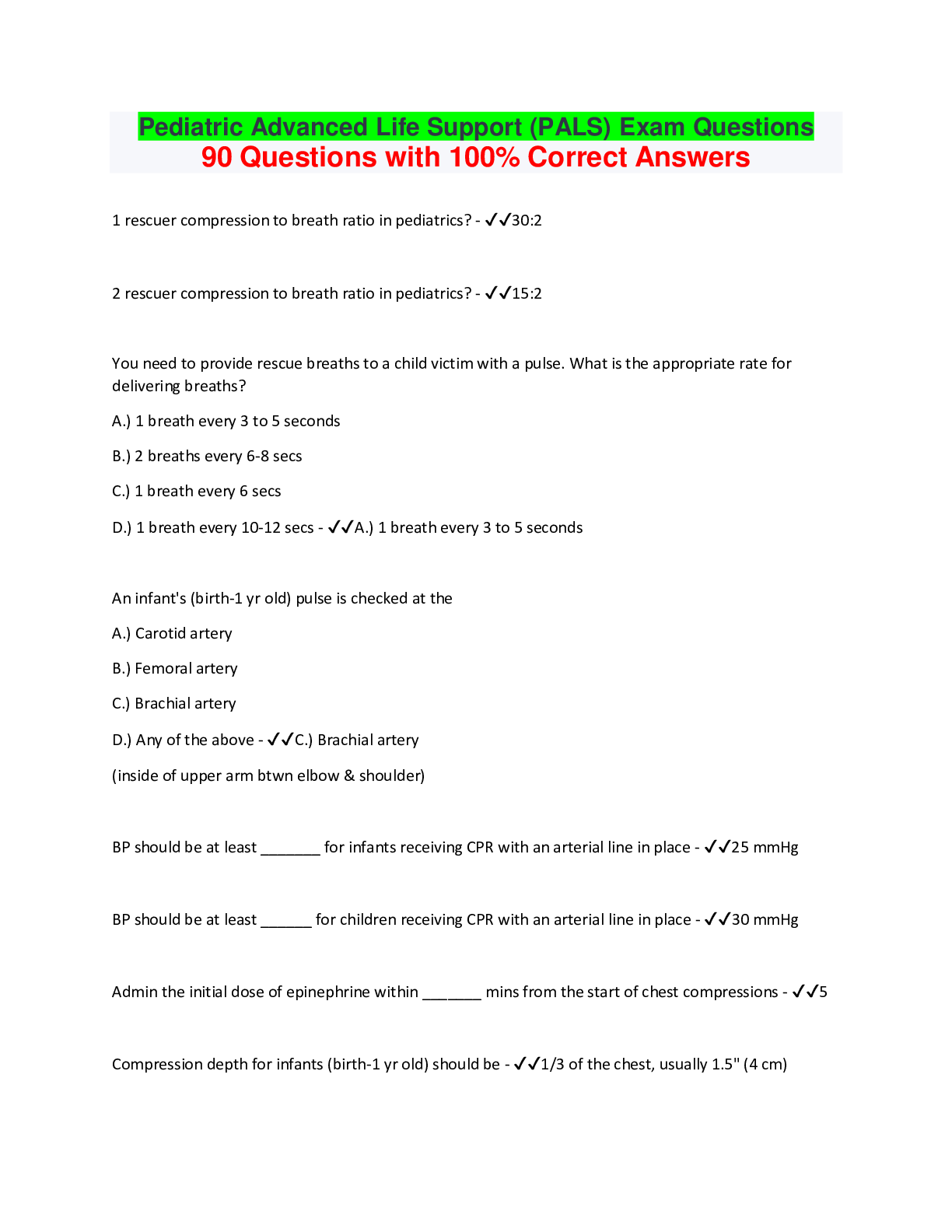
Buy this document to get the full access instantly
Instant Download Access after purchase
Buy NowInstant download
We Accept:

Reviews( 0 )
$7.00
Can't find what you want? Try our AI powered Search
Document information
Connected school, study & course
About the document
Uploaded On
Sep 03, 2022
Number of pages
19
Written in
Seller

Reviews Received
Additional information
This document has been written for:
Uploaded
Sep 03, 2022
Downloads
1
Views
204












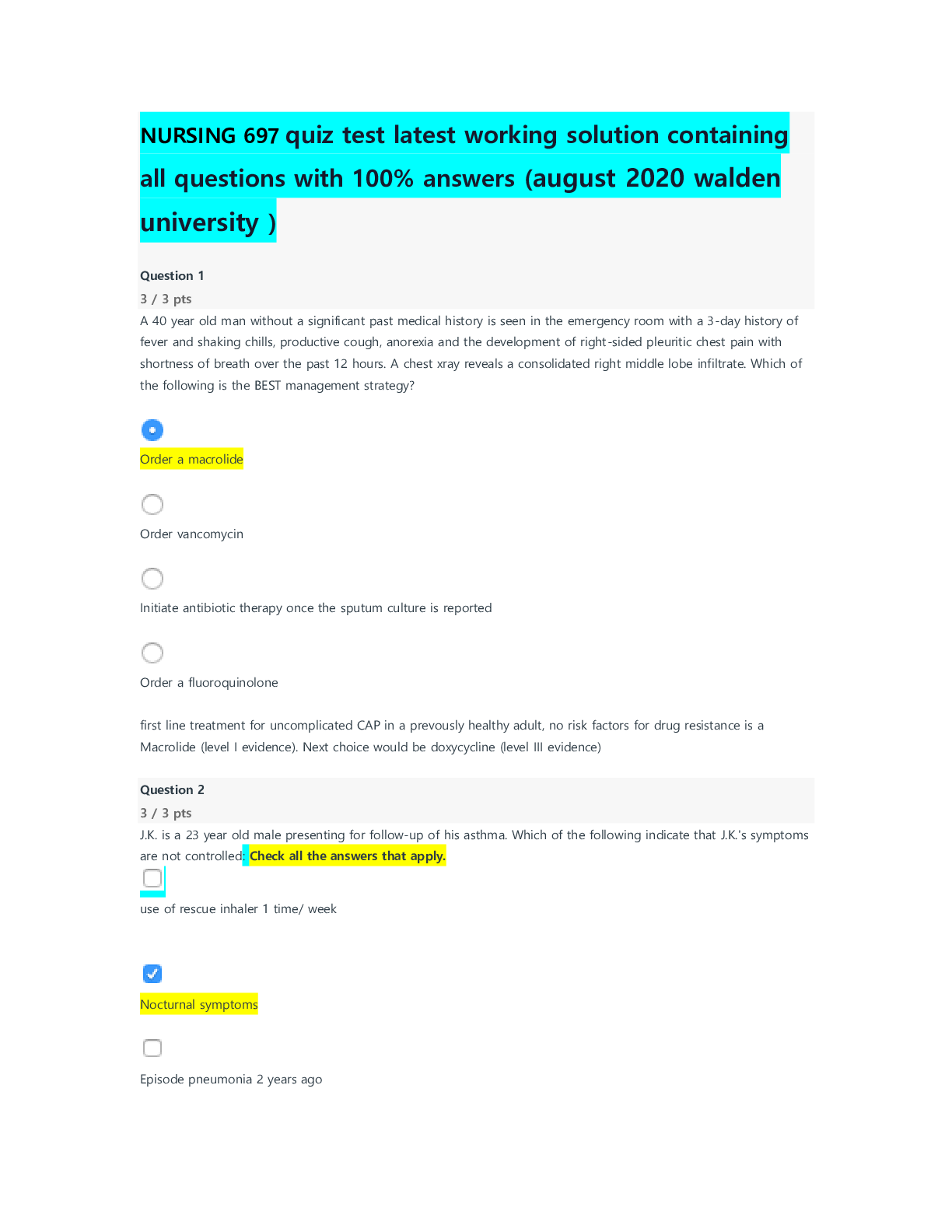


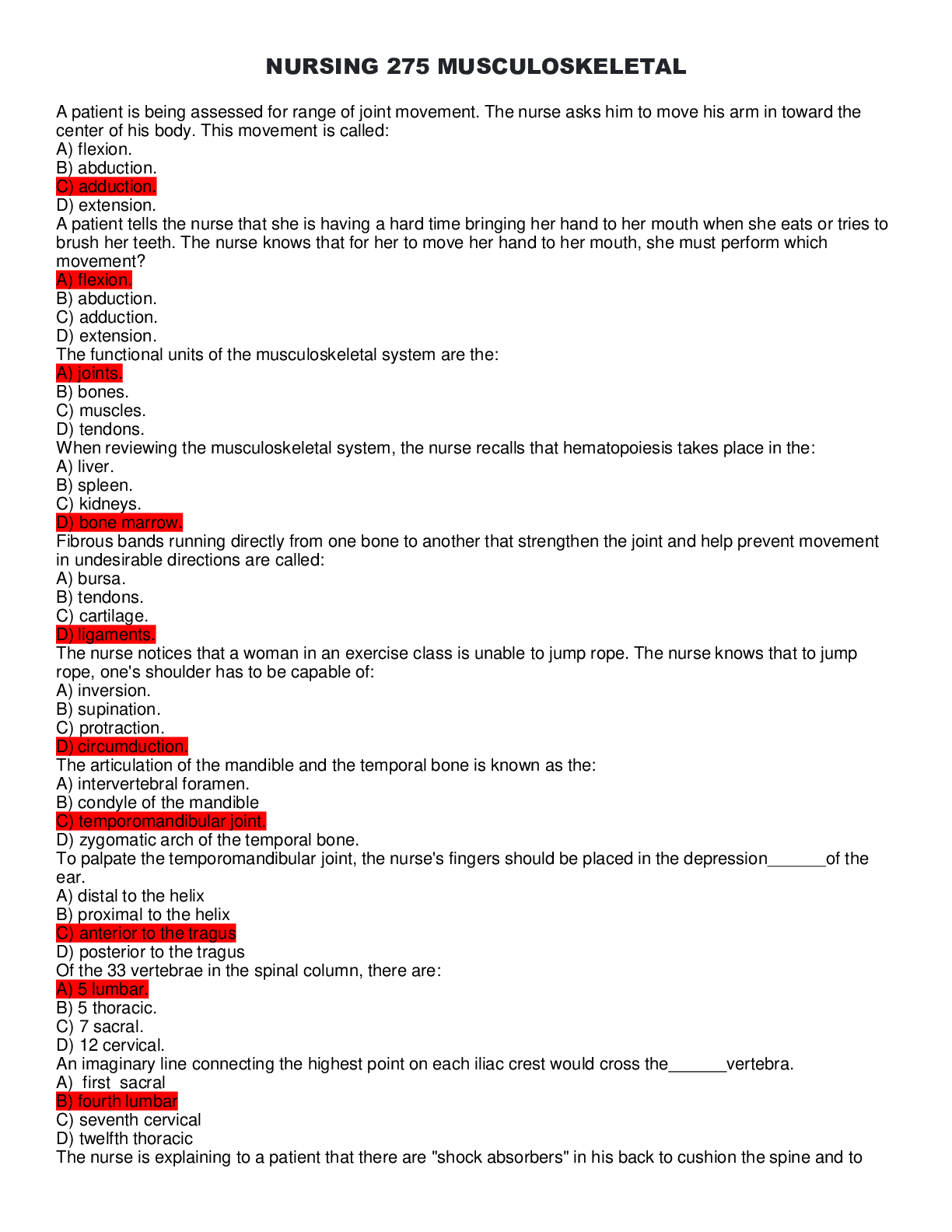




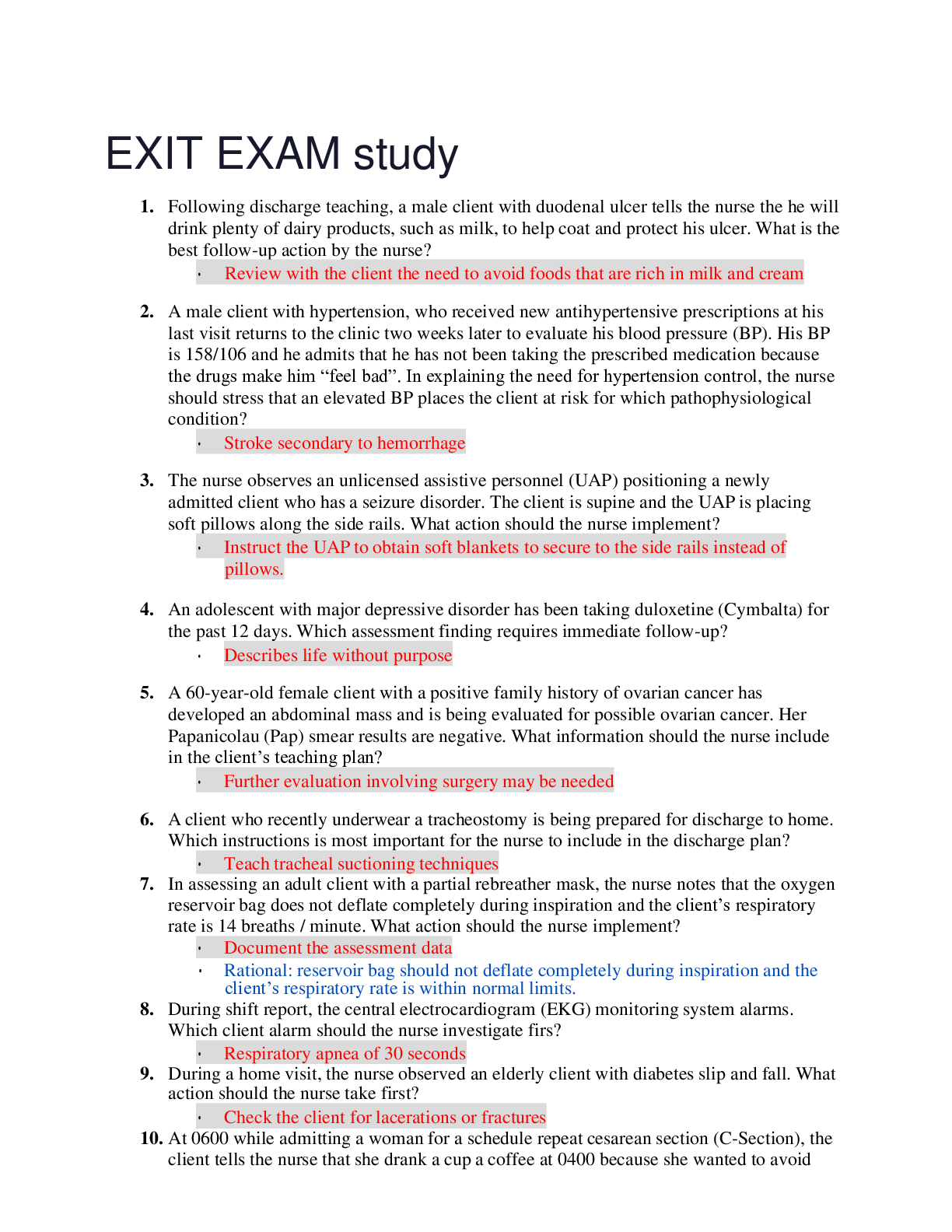
.png)
.png)
